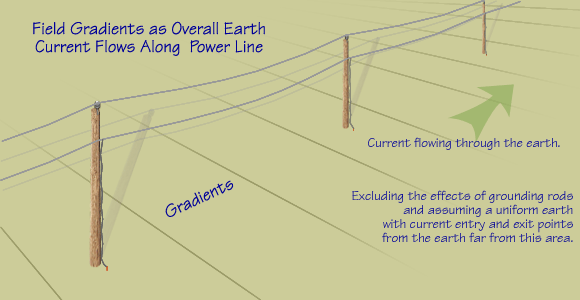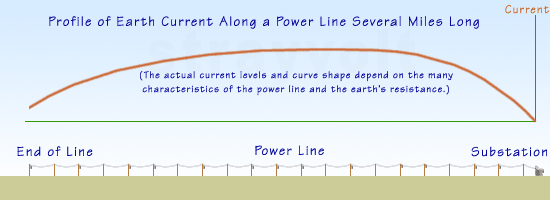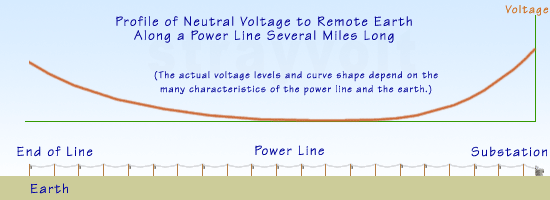Supply-Side Field Gradients |
|
|
|
Primary neutral current enters the earth and becomes earth current, which flows through the earth along
the power line forming field gradients much like the one we saw earlier
[Field Gd] in the two-rod study case.
In this section, we focus on the earth between power poles, far from ground rods
and any other grounding system. While there are many natural and man-made sources of earth current, as explained earlier, some of this current
is a portion of the primary return current that flows through the earth
rather than on the neutral conductor in its journey back to its source.
In overcoming the earth's resistance, this current causes voltage gradients
to form along the entire length of the power line as depicted in the figure. |
 
|

|
 
|
|
The current in the earth varies along the length of a power line.
The ground rods distributed along the power line provide the
jumpers for the current to leave the neutral wire and enter the earth, or
to return to the neutral wire from the earth.
This current redistribution is typical of all grounded power systems.
The amount of current that flows in the earth is determined by the type and size of the
primary neutral conductor, the occurrence and quality of grounding along the power line,
the conductivity of the earth, and other physical and electrical characteristics of the power line.
The field gradient varies similarly along the length of the power line.
|
|
In a theoretical model of a single-phase distribution system with evenly distributed
and equal grounding connections, static load conditions, and homogenous soils,
there would be a recurring pattern of earth current as shown in the figures below.
Current would tend to leave the neutral
conductor near the ends of the power distribution network, and
then rejoin the neutral conductor closer to the substation. This would occur
because the earth current has to close the current loop at the substation.
This is a characteristic effect of the physics of grounded circuits.
The distribution of the current in the earth along the line would assume
a typical upside-down
U-shape as shown in the figure below.
|
 
|

|
|
There is another curve with a reversed shape—an upright U—as shown in the figure below.
This is the neutral voltage along the power line, an item discussed later
[Neutral Voltage] that relates to gradients.
|
|
Real systems, however, are extremely complex. The uneven distribution and
quality of grounding connections, the effects of three-phase
systems, the wide variations in soil characteristics,
and the interconnections with other feeders
and other grounded utilities significantly distort and confound this basic pattern.
|
 
|

|
|
Supply-side field gradients tend to be the smallest of all gradients.
The current disperses in the earth while overcoming the
electric resistance of the earth on its way back to the substation source. This dispersion
limits the buildup and/or magnitude of gradients. |
|
|





|
